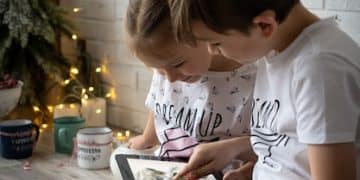Story Time Adventures: Engaging Reading Activities for Young Minds

Story Time Adventures offers a collection of five interactive reading activities designed to engage young minds aged 3-7, fostering a love for books and enhancing comprehension through playful and educational experiences.
Dive into the enchanting world of Story Time Adventures: 5 Interactive Reading Activities to Engage Young Minds (Ages 3-7)! Transform reading from a passive activity into an immersive experience, sparking creativity and building essential literacy skills.
Why Interactive Reading Matters for Young Children
Interactive reading transcends simply reciting words from a page. It’s about creating a dynamic exchange between the reader and the child, fostering engagement and deeper understanding.
By incorporating interactive elements, story time becomes a catalyst for cognitive development, emotional connection, and a lifelong love of reading. Let’s explore how these activities can benefit your child’s learning journey.
Boosting Comprehension and Vocabulary
Interactive reading helps children actively process information, enhancing their ability to understand and retain what they read. It also expands their vocabulary as they encounter new words in context.
Developing Critical Thinking Skills
By asking questions, encouraging predictions, and exploring characters’ motivations, interactive reading nurtures critical thinking and problem-solving abilities.
- ❓ Ask open-ended questions: “What do you think will happen next?”
- 🎭 Encourage role-playing: Act out scenes from the story.
- 🎨 Create art inspired by the book: Draw or paint characters and settings.
- 🗣️ Discuss the story’s themes: Talk about the lessons learned.
Integrating these elements into story time not only makes reading more enjoyable but also promotes essential cognitive skills that benefit children far beyond the pages of a book. Interactive reading transforms a passive listening experience into an active, engaged learning adventure.

In conclusion, interactive reading enriches a child’s comprehension, expands vocabulary, and cultivates critical thinking. By integrating these strategies, reading becomes a dynamic adventure, establishing an enduring enthusiasm for learning and literature.
Activity 1: The Prediction Game
The Prediction Game is a fantastic way to engage children’s imaginations and critical thinking skills during story time. It encourages them to actively participate in the narrative and think about what might happen next.
This activity transforms reading into a fun, interactive guessing game, sparking curiosity and boosting comprehension.
How to Play the Prediction Game
Pause at key moments in the story and ask questions like, “What do you think will happen next?” or “How do you think this character will solve the problem?” Encourage children to make predictions based on the information presented so far.
Benefits of Prediction Games
Prediction games not only make reading more exciting but also help children develop important skills such as inferencing, logical reasoning, and problem-solving.
- 🔮 Enhances inferential skills: Guessing what comes next.
- 🤔 Promotes critical thinking: Reasoning what may take place.
- 😃 Makes reading fun: Transforming it to a guessing game.
- 📚 Boosts comprehension: Better insight into narration.
The Prediction Game transforms story time into an interactive adventure, promoting critical thinking and solidifying comprehension. By engaging in this game, children cultivate inferential abilities and an enduring enthusiasm for the written word.
Activity 2: Character Role-Play
Character Role-Play brings stories to life by allowing children to step into the shoes of their favorite characters. This activity enhances their understanding of character motivations, emotions, and relationships.
By acting out scenes from the book, children develop empathy, improve their communication skills, and deepen their connection to the story.
Setting Up a Role-Play Activity
Choose a scene from the story and assign roles to the children. Provide simple props, costumes, or masks to enhance the experience. Encourage them to use different voices, gestures, and expressions to portray their characters.
The Benefits of Character Role-Play
Stepping into the role of story characters enhances empathy, hones communication skills, and makes a greater connection with the story. Role-playing enables children to analyze emotions and strengthen interpersonal skills, turning reading into an engaging and instructive adventure.
- 🎭 Enhances empathy: Put yourself in the protagonist’s shoes.
- 🗣️ Strengthens communication: Use voice and gestures.
- 🤹 Develops creativity: Be the storyteller.
- 💖 Promotes emotional understanding: Feelings of the character.

Character Role-Play transforms story time into a theater performance, fostering empathy and communication. By participating actively, children explore emotions and narrative, resulting in an immersive and educational experience that builds an enduring enthusiasm for reading.
Activity 3: Create a Story-Related Craft
Crafting connects literary concepts with tangible experiences, enhancing imagination and motor abilities. By creating crafts related to the story, children internalize narrative aspects and engage their creativity.
This activity transforms reading into an engaging multisensory experience, boosting their cognitive abilities and aesthetic appreciation.
Selecting a Story-Related Craft
Choose a craft that is directly related to the story, such as creating a character puppet, building a miniature setting, or designing a book cover. Provide children with a variety of materials, such as paper, paint, glue, and recycled items.
The Benefits of Crafting
Crafting helps children develop fine motor skills, spatial reasoning, and problem-solving abilities. It also encourages them to express their creativity and connect with the story on a deeper level.
- ✂️ Fine Motor Skills: Improves hands-on abilities.
- 🧪 Encourages Creativity: Unleash your imagination.
- 🖼️ Visual Understanding: Understand context by visualizing.
- 🤝 Brings Joy: Enjoy interactive play.
Making crafts connected to stories enriches children’s creative thinking, skills, and connection. Children engage with themes by making projects and turning reading to a hands-on encounter that promotes lifelong literacy.
Activity 4: The Sound Effects Adventure
The Sound Effects Adventure adds a dynamic auditory dimension to story time, enhancing imagination and creativity. By integrating sound effects, children actively become involved in crafting story’s atmosphere.
This activity transforms reading into an immersive, multisensory experience, promoting engagement and reinforcing memory of the plot.
How to incorporate sound
Allocate the sounds depending on the story moments. Use your own voices, make use materials around you, or use prerecorded sound effects from app. Stimulate imagination and story’s engagement.
The Benefits of sound
Sound Effects Adventure facilitates awareness, imaginative thinking, and teamwork. These elements stimulate children to become cognitively active which adds greater understanding of the narratives and stories structure.
- 🎼 Develops listening skills: Focus with every sound
- 💡 Encourages creative thought: Creative expression by auditory means
- 🤝 Strengthens partnership: Building interactive ambiance
- 🎭 Heightens involvement: Make stories memorable
Adding sound effects transforms reading into an adventurous sensory journey, nurturing imagination, and promoting active focus. Incorporating such experiences develops love towards books, and making it an enjoyable and educational part of the children.
Activity 5: Act Out The Story
Performing a narrative empowers kids by acting out plot, characters and setting it up; consequently encouraging a deeper engagement with the text and develop abilities.
Turning your readings into shows makes them feel very appealing while developing confidence, interpretation skills and creativity.
Setting up for the performance
Set easy scenes. Provide props and outfits that are easy to handle. Let them choose the roles and encourage spontaneity, building confidence during story hour and also fostering fun.
Why Acting boosts imagination
By means of the performance’s activity children will be able improve their memory, enhance an understanding of plot-lines and foster their critical thinking processes. It is an instructional method that converts story to a living and stimulating experience.
- 🎬 Improved Memory: Remember key details
- 🤔 Enhanced Thinking: Analysis story context
- 🎭 Boosts skills: Spontaneity expression
- 🎉 Makes reading a show: Stimulate love for literacy
Playing parts turns a book into an interactive experience and fosters abilities such as confidence and creative ideas. Act out tales to allow children learn with play which in turn sparks enthusiasm and love of learning.
| Key Point | Brief Description |
|---|---|
| 🔮 Prediction Game | Guess what happens next to boost inferential skills. |
| 🎭 Character Role-Play | Act out scenes to enhance empathy and communication. |
| 🎨 Story-Related Craft | Create crafts to connect with the story and improve skills. |
| 🎼 Sound Effects | Incorporate sounds to enhance imagination and involvement. |
Frequently Asked Questions
▼
These interactive reading activities are tailored for young minds aged 3-7, designed to engage their imaginations and foster a love for reading through age-appropriate activities.
▼
By integrating reading adventures, there are improved aspects such as asking kids and encouraging them in the role of acting things out; this boosts their narrative development as they become engrossed more deeply.
▼
Parents should introduce a range of materials, like clothes, props, and crafts relating to stories. Creating that interactive world generates excitement and also fosters in the child a curiosity to explore learning through playing.
▼
To foster participation make the readings with props, make it theatrical, and even musical to engage and help get them excited. This variety will enhance the fun aspect and help them be engaged with readings.
▼
Integrating sound effects introduces a sensory element into the session with stories. This boosts imagination, enables children be cognitively active and makes the narration experience even memorable and fascinating.
Conclusion
Incorporating these five interactive reading activities can transform story time into an enchanting and educational experience for young children. By engaging their imaginations, boosting their comprehension, and fostering a love for reading, you can set them on a path to lifelong learning and literary exploration.





